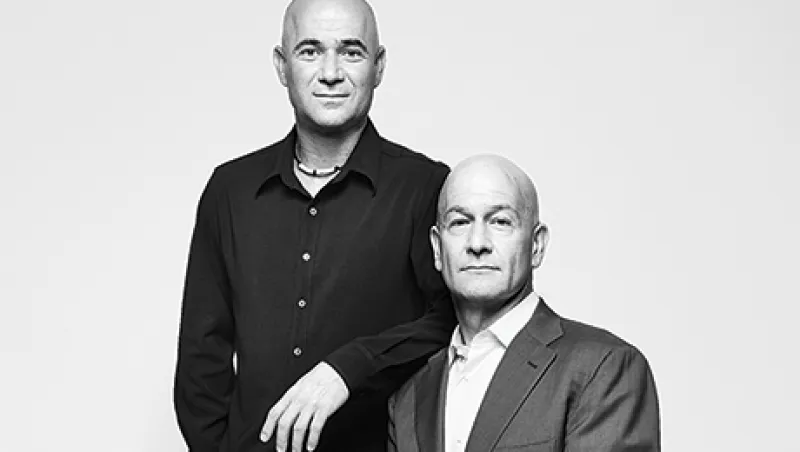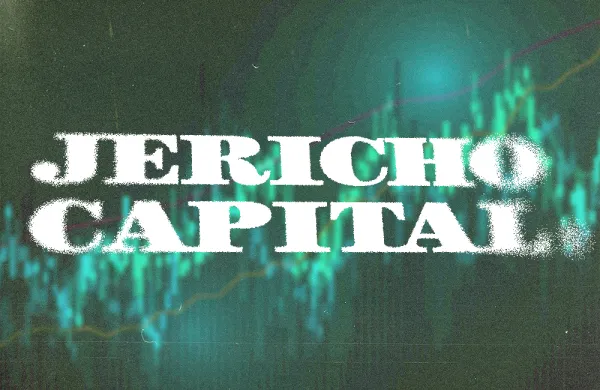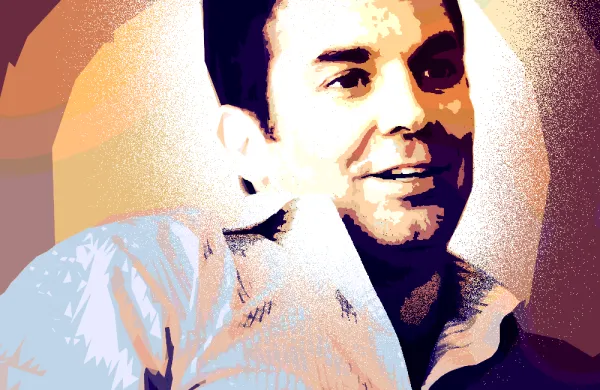Andre Agassi is not a morning person, at least not this day. As the former tennis star walks into a private meeting room at Manhattan’s Pierre hotel for an 8:30 a.m. photo shoot, he chides his partner, money manager Bobby Turner, for scheduling an early East Coast start. Agassi had arrived from his Las Vegas home the day before, went with Turner to Flushing Meadows in Queens to watch Roger Federer beat Richard Gasquet for a spot in the U.S. Open quarterfinals, then dined in Midtown before finishing the evening at the new Central Park South apartment of hedge fund manager Bill Ackman.
Yet Agassi shakes off the jet lag and gamely steps up to be photographed. “I’m not going to get any better looking as the day goes on,” he says. Then he sits down over breakfast to discuss his real passion: charter school education. He and Turner have teamed up to create a joint venture, the Turner-Agassi Charter School Facilities Fund, to support the sector. The firm just closed its second fund, expecting to raise $400 million in equity capital from investors including the University Endowment Fund of the University of Michigan and private wealth clients of Bank of America Merrill Lynch. Over the next five years, the fund, managed by Turner’s social investing outfit Turner Impact Capital, will invest some $1 billion to develop as many as 130 charter schools across the U.S. The venture’s first fund, launched in 2011, has to date built 50 schools educating a total of about 22,800 students.
Agassi, 45, earned much of his education on the courts. He began his professional tennis career in 1986, at the age of 16, and went on to win all four of the sport’s major titles. He started his own foundation in 2001, then devoted himself fully to philanthropy after retiring from the game in 2006, with a particular interest in at-risk youth and charter schools. He has raised $175 million over 15 years for charter schools, beginning with the Andre Agassi College Preparatory Academy, which opened in Las Vegas in 2001; its 2009 class had 100 percent graduation and college acceptance rates.
Agassi wrote about his charter school success in his 2009 autobiography, Open. When Turner, then a partner and head of the real estate business at Los Angeles–based money manager Canyon Partners, read the book, he had to get in touch.
“I reached out through his agent,” Turner says (not difficult, given that Canyon and the Creative Artists Agency, which represents Agassi and his wife, the equally accomplished tennis player Steffi Graf, are headquartered in the same Avenue of the Stars building in Los Angeles). After securing an introduction, the money manager set about convincing Agassi to go into the investment management business. “Andre was very skeptical” at first, Turner recalls. But Turner, 52, had an ace of his own. At Canyon he had partnered with basketball great Earvin (Magic) Johnson to develop the Canyon Johnson Urban Funds, which invest in inner-city communities and seek to foster opportunities for residents and address environmental concerns while achieving a market-rate return. He suggested they could do the same for charter schools by tapping the capital markets to magnify the impact that Agassi was already making. Unlike grants and gifts, investment dollars could create a flow of funds that would grow rather than shrink over time.
“I see one as a Band-Aid and the other as a medical cure,” Agassi says. “I realized that the model is really something that can work and I can help facilitate it. And I’ll be helping tens of hundreds of kids.”
The real estate funds help create charter schools by partnering with proven management teams and developing facilities, which are then leased back to the schools. Over the seven-year life cycle of each vehicle, the schools are intended to gain financial independence, likely by accessing the debt market or other sources. Combining debt and equity, the first fund, which Turner was able to take with him when he left Canyon to launch his own firm in 2014, had about $500 million in capital. Turner says that operating outside of Canyon makes it easier to pursue his triple bottom line objective.
The two don’t rule out the idea that a Turner-Agassi fund could receive an investment from a public pension plan, but Turner concedes it’s unlikely they’ll get any money from teachers’ retirement funds, given strong opposition to charter schools by teachers’ unions. “The difference between teachers’ unions and us: We represent the children,” Agassi says. “You need adults to be the advocates” for kids, he adds.
A bigger issue is the high failure rate of charter schools. Even the largely positive, and widely quoted, “2015 Urban Charter School Study Report on 41 Regions” from the Center for Research on Education Outcomes at Stanford University found that on average only 43 percent of urban charter schools perform better than their peers in math, and 38 percent in reading. In six regions, including Las Vegas, the overall performance of charter schools is lower than that of their traditional public school counterparts in either one or both disciplines. Agassi and Turner acknowledge that charter schools aren’t perfect, but they aim to avoid pitfalls by partnering with the best-in-class experts. “Our job is not to scale mediocrity,” Turner says.
Visit Imogen Rose-Smith’s blog and follow her on Twitter at @imogennyc.






